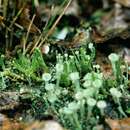en
names in breadcrumbs


Diphasiastrum is a genus of clubmosses in the plant family Lycopodiaceae. In the Pteridophyte Phylogeny Group classification of 2016 (PPG I), it is placed in the subfamily Lycopodioideae.[1] It is closely related to the genus Lycopodium, and some botanists treat it within a broad view of that genus as a section, Lycopodium sect. Complanata. Some species superficially resemble diminutive gymnosperms and have been given common names such as ground-pine or ground-cedar.
There are 16 species, and numerous natural hybrids in the genus; many of the hybrids are fertile, allowing their occurrence to become frequent, sometimes more so than the parent species. The basal chromosome count for this genus is n=23, which is distinctively different from other lycopods.
Several species have been used economically for their spores, which are harvested as Lycopodium powder.
As of January 2023, the Checklist of Ferns and Lycophytes of the World recognized the following species:[2]
Some species are treated as hybrids, although not by all sources:[2]
The genus has a subcosmopolitan distribution, in much of the Northern Hemisphere, south in mountains to South America (reaching furthest south in Jujuy Province, northwest Argentina), New Guinea and the Marquesas Islands in the Pacific Ocean, but confined to climates with high humidity for most or all of the year (or, in cool climates, protected by snow cover in winter).
 Diphasiastrum complanatum
Diphasiastrum complanatum Diphasiastrum is a genus of clubmosses in the plant family Lycopodiaceae. In the Pteridophyte Phylogeny Group classification of 2016 (PPG I), it is placed in the subfamily Lycopodioideae. It is closely related to the genus Lycopodium, and some botanists treat it within a broad view of that genus as a section, Lycopodium sect. Complanata. Some species superficially resemble diminutive gymnosperms and have been given common names such as ground-pine or ground-cedar.
There are 16 species, and numerous natural hybrids in the genus; many of the hybrids are fertile, allowing their occurrence to become frequent, sometimes more so than the parent species. The basal chromosome count for this genus is n=23, which is distinctively different from other lycopods.
Several species have been used economically for their spores, which are harvested as Lycopodium powder.